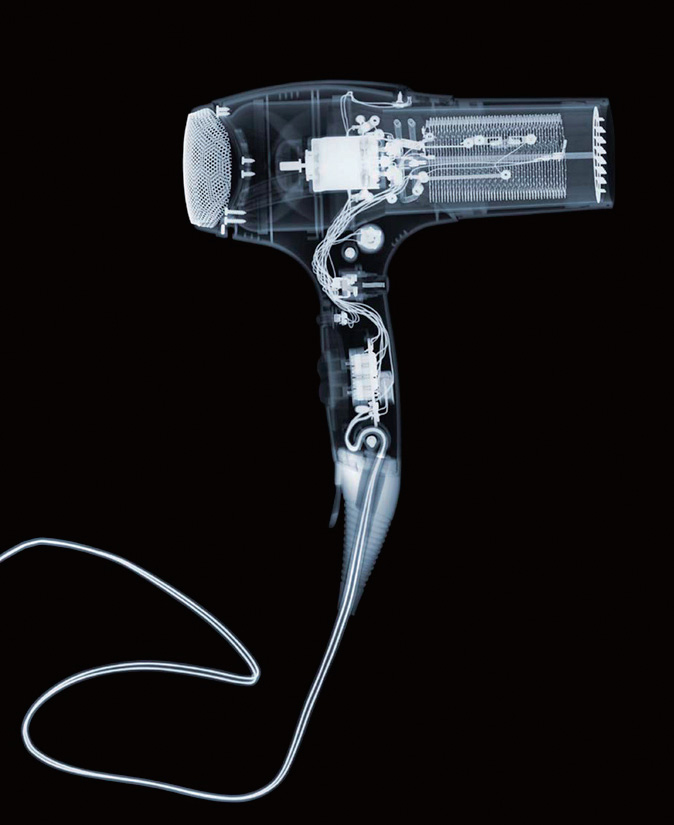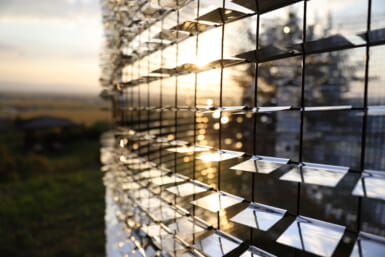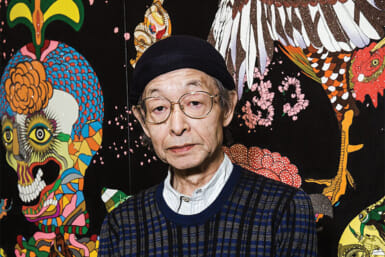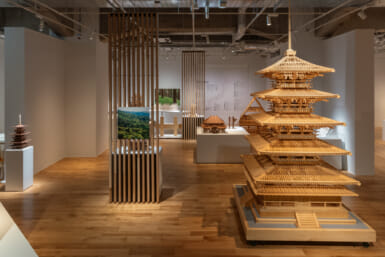by Owen Schaefer
The current exhibition at 21_21 Design Sight, Bones, is based on a single solid idea—that to take away the surface of a thing and expose its skeletal structure creates new understandings, both artistic and design-based. It’s an idea with a lot of promise, but unfortunately one that the directors have let run in too many directions rather than sticking to the bare bones of the issue.
This is not to say the show is bad. When Bones is good, the knee bone is connected to the leg bone, and the works not only shine individually, but inform one another. This is very much the case with Mongoose Studio’s Galvanic Frame—a series of wire-frame benches linked to computers which read the stress at each joint as viewers sit down, and feed the information back as sound and light to give a visceral sense of the way in which weight is distributed at different parts of the bench. The work is followed up closely by Crash, a slow-motion computer simulation of remarkably similar truss-based structures as they fall and shatter. Similarly, Another Shadow reconstructs the viewer’s shadow as a two-dimensional skeleton of truss-like triangular forms, animating it in a limited capacity, recalling the stresses and breaking points of the previous two.
There are also strong conceptual links between Skeleton Automata ‘YUMIHIKI on a Boat’ and the easily overlooked Pavane for Invisible Strings. The Yumihiki automata is a functioning archer doll that draws an arrow, nocks the bow, and shoots. Originally drawn by Shunji Yamanaka and then put together by master craftsman Shobei Tamaya, the work subverts the usual approach to automata by foregoing surface details and revealing the normally hidden skeleton. But taking an almost opposite approach, artistic group Mile uses the ‘skeleton’ of a piano (the functioning mechanism, rather than the actual supportive trusses) and imagines it as something never before seen, thus mimicking the scientific process of ‘re-building’ an object’s outer appearance from its bones alone, and getting it humorously wrong.
As a backbone to all of this, Kotaro Maeda’s Endoskeleton Spiders occupy both the physical and ideological center of the show. Real spiders, of course, do not have skeletons, but are armored and supported on the outside and have their soft tissues inside. Maeda has created eerily real skeletons for an imaginary breed of vertebrate spiders, which seem to scuttle throughout the courtyard. This evolutionary reversal finds echoes in many of the concepts and works in Bones, (including Pavane for Invisible Strings) and acts as a sculptural mirror to Eiji Yuzawa’s animal skeleton photographs and an organic counterpart to the scuttling robot insect Phasma.
All of this sounds great, and it is. But what ultimately keeps Bones from standing perfectly upright is an unfortunate amount of purely peripheral material. In the ‘specimen’ area of the show, a number of artificial surgical bones make an interesting study, and even a set of dissected designer watches have at least an atmospheric relevance. But less meaningful inclusions, such as cell phones, dismantled washing machines, and Sony’s Rolly MP3 player add nothing to the show.
Likewise, the robotic sculpture Flagella, a genuinely fascinating object in itself, fails to find solid ground, largely because it has been included as an example of using hard materials to mimic boneless forms—and with the effect really more of an illusion than a functioning design, it ends up feeling something of a parlor trick when placed against the rest of the exhibition.
Trimming a little of the fat from Bones might have made this good show great.
Show: Bones (to Aug 30) Gallery: 21_21 Design Sight (Roppongi station) Hours: 11am–8pm (closed Tue) Admission: ¥1,000 Tel: 03-3475-2121 www.2121designsight.jpTel:











